April 2019
By Rebecca Davis Gibbons
Foreign policy pundits have bemoaned the unraveling of the post-World War II international order in recent years, describing threats to the multilateralism and liberalism enshrined in postwar institutions. An often overlooked component of that structure is the global nuclear order, which, like other parts of the postwar system, was created for magnanimous and selfish aims: reducing the dangers of nuclear weapons for all and serving the interests of the world’s most powerful states.
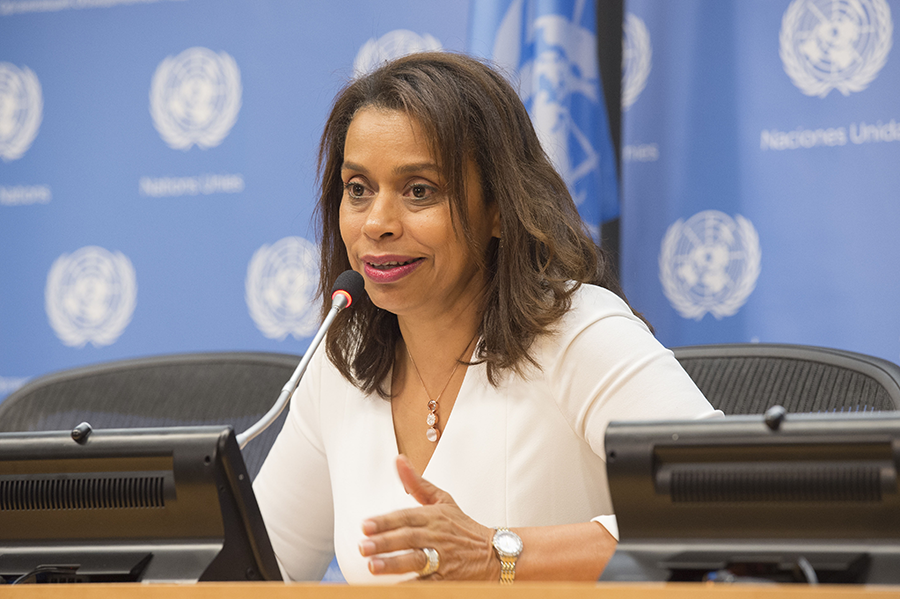 Today, the global nuclear order is also at risk of unraveling. Taken for granted for too long, the nuclear order requires visionary leaders with the same foresight as the postwar order-makers to undertake bold measures in search of a renewed bargain between nuclear-armed and non-nuclear nations.
Today, the global nuclear order is also at risk of unraveling. Taken for granted for too long, the nuclear order requires visionary leaders with the same foresight as the postwar order-makers to undertake bold measures in search of a renewed bargain between nuclear-armed and non-nuclear nations.
Challenges to the Global Nuclear Order
The long-established global nuclear order, as scholar William Walker has explained, comprises two linked systems of order. First, there is the “managed system of deterrence,” by which the nuclear powers, mainly the United States and Soviet Union and later Russia, have pursued deterrence and stability in a rule-bound system, such as with arms control agreements. Second, there is the nuclear nonproliferation order, in which many states have agreed not to develop nuclear weapons in exchange for specific benefits.1
Both systems are faltering. Within the deterrent order, U.S. and Russian leaders are failing to maintain traditional arms control treaties and increasing the salience of nuclear weapons. Pointing to Russian cheating, the United States has announced it will withdraw from the 1987 Intermediate-Range Nuclear Forces (INF) Treaty in August, and Russia is following suit. The current U.S. administration has not yet shown an interest in extending the 2010 New Strategic Arms Reduction Treaty (New START) after it is set to expire in 2021. As restrictions are being lifted, Russia and the United States are exploring destabilizing weapons advancements. Last year, President Vladimir Putin announced a series of new nuclear military capabilities, including a nuclear torpedo and a nuclear cruise missile, neither of which is constrained by current arms control agreements.2 In recent weeks, the United States announced plans to test previously banned intermediate-range weapons after its INF Treaty withdrawal is complete.3
The nuclear nonproliferation order is in no better shape, primarily due to the pace of nuclear disarmament.4 Reflecting this concern, 122 nations, but nary a nuclear-weapon state, voted in July 2017 to adopt a treaty prohibiting nuclear weapons. Making the argument that nuclear weapons use is inconsistent with international humanitarian law, these states and their civil society partners have sought to stigmatize nuclear weapons and nuclear deterrence.5
U.S. and Russian plans to modernize their nuclear arsenals further exacerbate tensions with non-nuclear nations, as many believe the two powers are not adhering to their nuclear Nonproliferation Treaty (NPT) obligation to pursue negotiations toward disarmament. With one side viewing nuclear weapons as inherently immoral and the other seeing nuclear deterrence as a way to maintain security for itself and its allies, there appears to be little space to bridge this divide until the nuclear possessor states move toward nuclear reductions and disarmament.
To make matters worse, NPT parties will this month begin the final preparatory committee meeting before the treaty’s review conference next year, when they will be reminded that 2020 marks the 25th anniversary of the 1995 decision to extend the treaty indefinitely. The United States and many of its allies pushed hard for indefinite extension in the 1990s, while some non-nuclear-weapon states sought a more limited 25-year extension, recognizing they would lose leverage over the nuclear states if the treaty were extended permanently. Current nuclear trends surely cause many states to regret the 1995 decision.
The divisions among the NPT community and between the United States and Russia are difficult enough, but they will have to be addressed in a world markedly different than the Cold War period when the two nuclear orders were established by the two superpowers. China, the second-largest economy in the world, is modernizing its military, including its nuclear arsenal, but has little experience in the negotiations and transparency required by nuclear arms control treaties. Other states are rising as well, indicating an emerging multipolar world. Finally, the rise of information technology has eased high-speed communication around the globe, allowing for individuals and groups to connect and coordinate for a variety of purposes, including advocacy. The reach and influence of the International Campaign to Abolish Nuclear Weapons
is evidence of this relatively new form of power.
Short-Term Forecast
The year 2020 marks the 50th anniversary of the NPT’s entry into force. Although this milestone warrants celebration, important work remains. It is unlikely the NPT, the cornerstone of the nonproliferation order, will face a mass exodus of states soon; but without change, it will likely suffer a slower but no less consequential death. Lower-ranked officials will come and give routine speeches at NPT meetings, but little of importance will happen because states will not prioritize the treaty. The NPT will no longer be a vehicle for states to discuss important issues of nuclear disarmament, nonproliferation, and peaceful uses of nuclear technology. It will calcify in a manner similar to the UN Conference on Disarmament, which has not completed a treaty in more than 20 years.
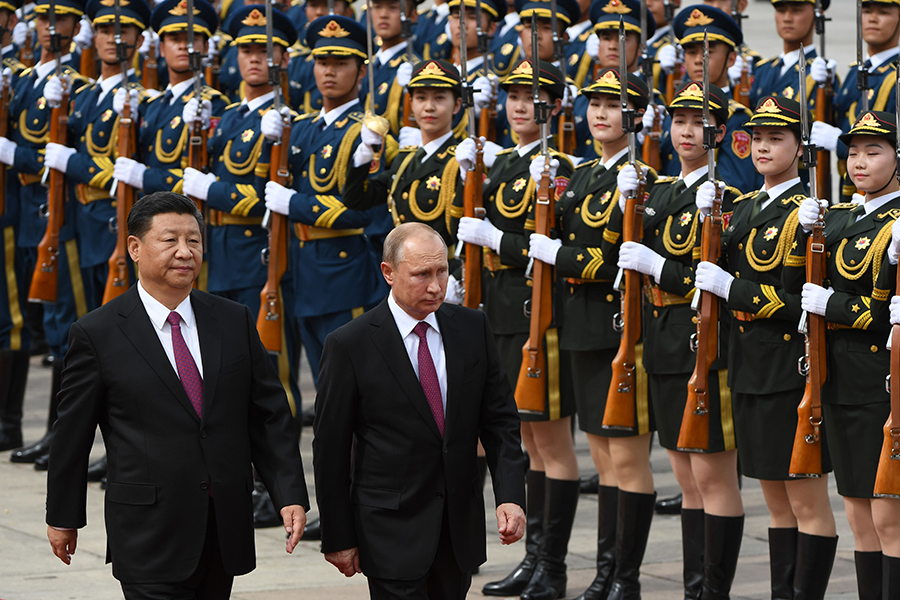 Disagreement over the pace of disarmament is at the heart of the current NPT divide. In December 2018, Christopher Ford, U.S. assistant secretary of state for international security and nonproliferation, argued that the U.S. arsenal has come down to such low numbers that the traditional step-wise nuclear reductions of the past are no longer prudent. Instead of further reductions, the United States seeks to work with other states to identify the obstacles to disarmament and address them. The plan, now called “Creating an Environment for Nuclear Disarmament” (CEND), is for working groups of 25 to 30 states each to meet and explore ways to overcome specific challenges. At the 2018 NPT Preparatory Committee meeting, the United States issued a working paper that identified a set of goals that Washington argued would enable further arms reductions.6 These included denuclearizing North Korea, addressing regional tensions and conflicts, establishing a Middle Eastern zone free of weapons of mass destruction, achieving universal compliance with International Atomic Energy Agency (IAEA) safeguards, and improving transparency surrounding nuclear doctrines and arsenals.7
Disagreement over the pace of disarmament is at the heart of the current NPT divide. In December 2018, Christopher Ford, U.S. assistant secretary of state for international security and nonproliferation, argued that the U.S. arsenal has come down to such low numbers that the traditional step-wise nuclear reductions of the past are no longer prudent. Instead of further reductions, the United States seeks to work with other states to identify the obstacles to disarmament and address them. The plan, now called “Creating an Environment for Nuclear Disarmament” (CEND), is for working groups of 25 to 30 states each to meet and explore ways to overcome specific challenges. At the 2018 NPT Preparatory Committee meeting, the United States issued a working paper that identified a set of goals that Washington argued would enable further arms reductions.6 These included denuclearizing North Korea, addressing regional tensions and conflicts, establishing a Middle Eastern zone free of weapons of mass destruction, achieving universal compliance with International Atomic Energy Agency (IAEA) safeguards, and improving transparency surrounding nuclear doctrines and arsenals.7
The goal of solving global conflicts to establish more amenable conditions for future disarmament is laudable, but there are significant challenges inherent in the working group approach. With the current administration’s rejection of multilateral strategies, such as the Iran nuclear deal and the Paris climate agreement, U.S. leaders are not in the best position to lead a multilateral effort.
Furthermore, there is the question of who will participate in the CEND meetings. Will these working groups include the diverse membership the United States seeks? As the CEND initiative was presented as an alternative to the nuclear prohibition treaty, it would not be surprising if prohibition treaty proponents choose not to participate. After all, the prohibition treaty and the CEND process take conflicting normative approaches to nuclear weapons. For the prohibition movement, these are immoral weapons at odds with international humanitarian law—possession has no justification. In contrast, underlying the CEND initiative is the idea that these weapons are necessary and appropriate tools of deterrence as long as certain geopolitical conditions exist.
In addition, it is difficult to imagine China and Russia engaging productively in this new approach. Both states regrettably have already left the International Partnership for Nuclear Disarmament Verification (IPNDV), the organizational model for the CEND process. The partnership is undertaking important work addressing the many technical and political challenges of future nuclear warhead verification. China and Russia send an unfortunate message by choosing not to attend future meetings.
It seems probable that only the United States and its allies and partners will participate in the CEND work. If so, the approach will worsen divisions that already strain the nuclear order. Surely, the United States is not in an enviable position. On one side, to those seeking a nuclear weapons ban, the CEND initiative looks like a way for the United States to appear to make progress on disarmament without taking meaningful steps toward nuclear reductions. On the other hand, Washington appears to lack partners for a real arms control discussion, as demonstrated by the Russian and Chinese decisions to skip IPNDV meetings. One step in the right direction would be for the United States to seek a five-year extension on New START. This is the least the United States can do to keep the deterrent order on life-support until there is an opportunity to work constructively with Russia again.
Envisioning the Next Nuclear Order
The preservation of the nuclear order will not succeed without the type of dedicated and visionary leadership that led to post-World War II arrangements. Although near-term prospects are dim, a reinvigorated nuclear order will require current and emerging global powers to create a renewed consensus that addresses the challenges to the deterrent order and the nonproliferation order. In broad strokes, this new consensus includes a widened circle of nuclear nonproliferation state-leaders to reflect changing power dynamics, a renewed and more credible commitment to reducing nuclear dangers, and strategic dialogues to reduce risk and mitigate conflict among nuclear weapons possessors.
A sustainable nuclear order for the 21st century must accommodate changing global power dynamics. Based on economic projections, China, India, Brazil, and Indonesia are anticipated to be among the top powers by 2050, with India and China expected to surpass the United States by gross domestic product by 2030.8 Emerging powers should be invited and encouraged to assume leadership roles within a renewed nonproliferation order. This change should not be too difficult; just as the United States and the Soviet Union sought to limit the number of nuclear weapons possessor states for strategic reasons,9 so too will rising powers prioritize proliferation as their interests become global. Nonetheless, without encouragement, these powers may continue to rely on the United States to hold the line on proliferation as it has since the end of the Cold War. U.S. leaders can assist China and India by consulting on past and present U.S. nonproliferation diplomacy and encouraging greater transparency about their nuclear arms. The interests of Indonesia and Brazil also must be weighed in any new consensus. Indonesia has long been a proponent of nuclear disarmament and led the charge for 25-year rolling extensions at the 1995 NPT Review and Extension Conference. Brazil was one of the last states to join the NPT, doing so in 1998. Its late accession reflects Brazil’s complicated relationship with the nuclear nonproliferation order. Most recently, Brazil has refused to conclude an additional protocol to its IAEA safeguards agreement, but it was an important leader in the negotiations toward the nuclear prohibition treaty.
Together, the established and emerging global powers should pledge publicly to work together in a political process to promote nuclear nonproliferation. The new consensus should accept the IAEA Model Additional Protocol as the global safeguards standard and add constraints on any additional sites for enrichment and reprocessing. These sensitive technologies were not mentioned in the NPT text, and some states have claimed it is their “right” under the treaty to possess such technology for peaceful uses. A new consensus should reject this idea while credibly committing to providing a wide range of civilian nuclear technology, including access to enriched uranium for peaceful uses through the global marketplace with additional assurances through global fuel banks.
In a renewed nonproliferation consensus that brings India into the leadership of the nonproliferation order, Israel, North Korea, and Pakistan should be included in meetings and discussions as nuclear weapons possessor states. This de facto expansion of possessor states in a new nuclear nonproliferation order could only occur alongside a commitment by all nuclear weapons states to play a role in the deterrent order by reducing the role of nuclear weapons, seeking risk reduction measures, making significant nuclear reductions, and eventually pursuing disarmament. Incorporating all current nuclear weapons states into this political process matters because none of them should be able to avoid these commitments.
To make these commitments more credible after decades of broken promises, the nuclear possessor states should develop a sequence of steps, beginning with further U.S. and Russian reductions, that would put them on a path toward strategic stability and a reduced reliance on nuclear weapons. These steps could include changes in nuclear posture, such as removing nuclear weapons from high alert levels over time and separating warheads from delivery vehicles. In addition, the new steps could be made within a context in which nuclear weapons, conventional strategic weapons, and missile defenses are all on the negotiating table.10 Exclusively focusing on strategic nuclear weapons will not be effective. The more powerful nuclear-armed states could offer inducements in the form of aid to the other nuclear states to keep them participating in the process.
While working through these complex strategic issues, the major powers should identify and mitigate the conflicts that underlie their perceived need for nuclear weapons. In this way, the CEND initiative represents an important idea but one that requires buy-in from the highest levels of leadership in all nuclear weapons states. During this process, all states would contribute to improving verification technology and protocols for a world with many fewer nuclear weapons. Furthermore, as states dismantle weapons or down-blend nuclear weapons-grade fuel, they should keep meticulous records of the activities so the information would be useful in a future disarmament process.11
All of the above sounds far-fetched in the current geopolitical environment, but one factor that could help push forward a new nuclear consensus is the nascent norm against nuclear weapons possession. The still emerging norm could increasingly affect the thinking of citizens around the world as they become concerned about the loss of traditional arms control agreements, the development of new nuclear weapons, and new arms races. Beginning a process of greatly reducing the number of nuclear weapons would be much easier for leaders if their citizens thought possessing such weapons were wrong.
Crafting the NPT was challenging for the two Cold War-era superpowers. Developing a renewed bargain in a more multipolar system, even a tacit one that is political in nature and does not necessarily require new treaties, will be much more difficult. The leaders of the relevant states must be motivated to make a generational commitment to major changes to sustain the nuclear order. This is a task on par with addressing global climate change; it is a job for visionary leaders. Of the many challenges inherent in this process, maintaining momentum through executive leadership changes is one of the toughest. There is no hard and fast way for leaders to tie the hands of their successors, but by engaging the public and seeking its buy-in for the process, leaders increase the chance that their successors will continue moving forward.
Some U.S. leaders may reject the notion that a new nuclear order is needed. They may be happy to be free of the NPT disarmament obligation if the treaty collapses. After all, some already see it as merely a convenient fiction that helps maintain the NPT and reduces proliferation pressures. Yet, rejecting the commitment to disarm and losing the nonproliferation order risk a world in which capable states perceive fewer constraints on pursuing proliferation activities. In other words, even if one thinks the treaty’s disarmament requirement is a convenient fiction, it cannot last in perpetuity. It is not feasible to expect states to remain non-nuclear-weapon possessors without a disarmament commitment, a promise that has existed for 50 years. The disarmament movement would be further catalyzed by the United States and other nuclear-weapon states walking away from the commitment to negotiate eventual disarmament.
These tasks are immense. A world with multiple rising powers, a declining superpower, and influential civil society activists is one in which new political bargains will be difficult to forge. Even the most compelling leaders will be challenged by these order-sustaining projects. Yet, not taking up the challenge to adapt the nuclear order to new political realities means an increasingly nuclear-armed world in which nuclear war and nuclear accidents become more likely.
ENDNOTES
1. William Walker, “Nuclear Order and Disorder,” International Affairs, Vol. 76, No. 4 (October 2000): 703–724.
2. For a broader discussion of the breakdown of the nuclear order, see Steven E. Miller, Robert Legvold, and Lawrence Freedman, “Meeting the Challenges of the New Nuclear Age: Nuclear Weapons in a Changing Global Order,” American Academy of Arts and Sciences, 2019, pp. 19–26, https://www.amacad.org/sites/default/files/publication/downloads/2019_New-Nuclear-Age_Changing-Global-Order.pdf.
3. Robert Burns, Associated Press, “U.S. Plans Tests This Year of Long-Banned Types of Missiles,” March 13, 2019, https://www.apnews.com/ea243a96bc254378ba92f1e3e8761389.
4. For example, see Rebecca Davis Gibbons, “Our Deep Divide Over Nuclear Disarmament,” The Hill, December 11, 2018.
5. Rebecca Davis Gibbons, “The Humanitarian Turn in Nuclear Disarmament and the Treaty on the Prohibition of Nuclear Weapons,” The Nonproliferation Review, Vol. 25, Nos. 1–2 (2018).
6. Preparatory Committee for the 2020 Review Conference of the Parties to the Treaty on the Non-Proliferation of Nuclear Weapons, “Creating the Conditions for Nuclear Disarmament (CCND): Working Paper Submitted by the United States,” NPT/CONF.2020/PC.II/WP.30, April 18, 2018.
7. For more on this approach, see Rebecca Davis Gibbons, “Can This New Approach to Nuclear Disarmament Work?” War on the Rocks, January 23, 2019, https://warontherocks.com/2019/01/can-this-new-approach-to-nuclear-disarmament-work/.
8. Of course, long-term economic forecasting is an uncertain enterprise. For one recent study of the future economic order, see “The Long View: How Will the Global Economic Order Change by 2050?” PricewaterhouseCoopers, February 2017, https://www.pwc.com/world2050.
9. On the argument that great powers care more about nuclear proliferation than other states, see Matthew Kroenig, “Exporting the Bomb: Why States Provide Sensitive Nuclear Assistance,” American Political Science Review, Vol. 103, No. 1 (2009): 113–133.
10. A number of organizations and analysts have considered how such reductions could take place. See for example, the Deep Cuts Commission, the Nuclear Threat Initiative, Global Zero, and the work by James Acton and George Perkovich at the Carnegie Endowment for International Peace. For a treatment of U.S.-Russian reductions, see Justin Anderson and Darci McDonald, “Deter and Downsize: A Paradigm Shift for Nuclear Arms Control,” Arms Control Today, March 2017, pp. 15–20.
11. Sebastian Philippe, discussion with author, March 2019.
Rebecca Davis Gibbons is a postdoctoral research fellow with the Project on Managing the Atom and International Security Program at the Belfer Center for Science and International Affairs at Harvard University, where her research focuses on nonproliferation and the movement to prohibit nuclear weapons.
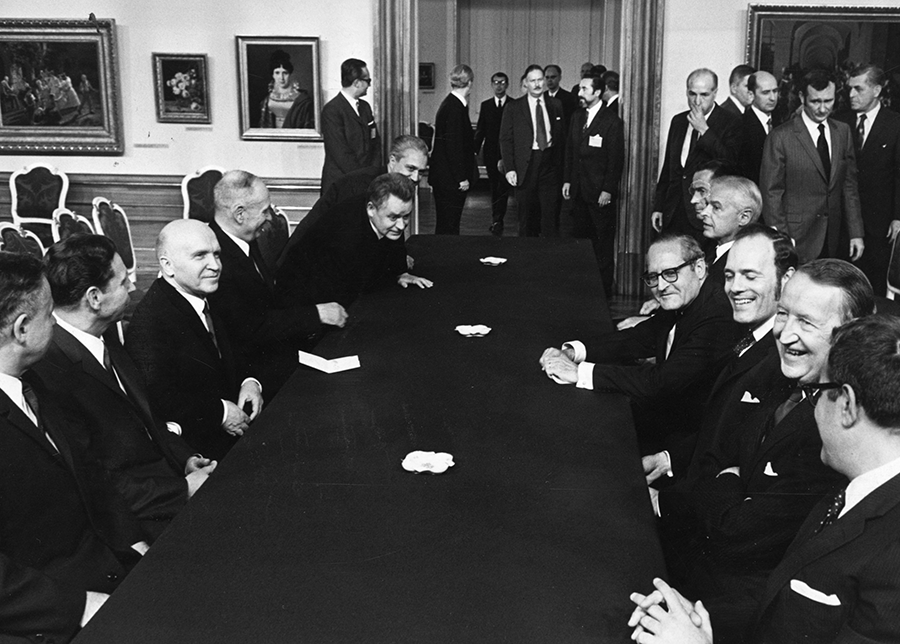 The size of U.S. and Russian nuclear stockpiles has decreased significantly from their Cold War peaks, but the dangers posed by the still excessive arsenals and launch-under-attack postures are even now exceedingly high.
The size of U.S. and Russian nuclear stockpiles has decreased significantly from their Cold War peaks, but the dangers posed by the still excessive arsenals and launch-under-attack postures are even now exceedingly high.





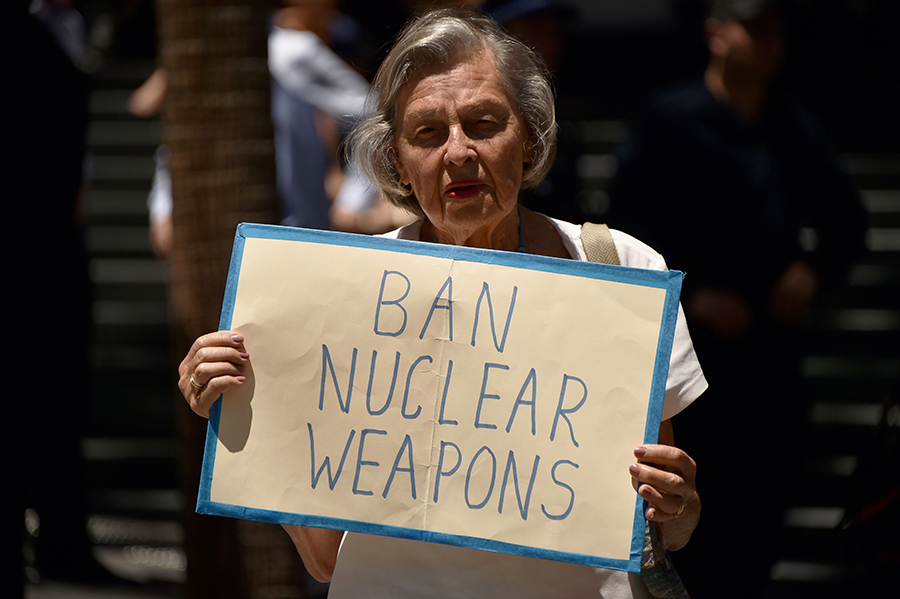 The new treaty has posed a major challenge to the status quo. Backed by 122 states at the time of its adoption, the treaty has now garnered 70 signatures and 22 ratifications, with 50 ratifications needed for the pact to enter into force. Some nuclear powers, particularly the United States, have begun new initiatives to try to maintain their control over the direction of NPT activity.
The new treaty has posed a major challenge to the status quo. Backed by 122 states at the time of its adoption, the treaty has now garnered 70 signatures and 22 ratifications, with 50 ratifications needed for the pact to enter into force. Some nuclear powers, particularly the United States, have begun new initiatives to try to maintain their control over the direction of NPT activity.
 This stance, however expedient for allies, ignores the reality that the international security environment was hardly any better during the Cold War, yet the alliance made great efforts with considerable success to devise agreements to reduce arms and promote cooperation. Nine years after the Strategic Concept, there is still no more wisdom regarding what NATO deems to be the essential conditions for nuclear disarmament
This stance, however expedient for allies, ignores the reality that the international security environment was hardly any better during the Cold War, yet the alliance made great efforts with considerable success to devise agreements to reduce arms and promote cooperation. Nine years after the Strategic Concept, there is still no more wisdom regarding what NATO deems to be the essential conditions for nuclear disarmament Such a major departure in disarmament diplomacy would normally have been a product of extensive prior consultation with affected allies and partners, but there is no public evidence that this has occurred. Indeed, this new doctrine pulls the carpet from underneath U.S. allies and partners who have dutifully been affirming the superiority of the step-by-step approach to fulfilling the NPT’s nuclear disarmament obligations. Particularly in the context of the diplomatic struggle over the humanitarian initiative and the development of the prohibition treaty, the U.S. nuclear dependents have faithfully argued the merits of the step-by-step, or progressive, approach to achieving nuclear disarmament. One illustration was given at the UN General Assembly First Committee last fall on the part of 30 non-nuclear-weapon states allied with the United States through NATO or bilateral accords. These states declared, “We are firmly committed to the goal of a nuclear-weapon-free-world and believe it is best pursued through a progressive approach consisting of pragmatic, inclusive and effective steps.”
Such a major departure in disarmament diplomacy would normally have been a product of extensive prior consultation with affected allies and partners, but there is no public evidence that this has occurred. Indeed, this new doctrine pulls the carpet from underneath U.S. allies and partners who have dutifully been affirming the superiority of the step-by-step approach to fulfilling the NPT’s nuclear disarmament obligations. Particularly in the context of the diplomatic struggle over the humanitarian initiative and the development of the prohibition treaty, the U.S. nuclear dependents have faithfully argued the merits of the step-by-step, or progressive, approach to achieving nuclear disarmament. One illustration was given at the UN General Assembly First Committee last fall on the part of 30 non-nuclear-weapon states allied with the United States through NATO or bilateral accords. These states declared, “We are firmly committed to the goal of a nuclear-weapon-free-world and believe it is best pursued through a progressive approach consisting of pragmatic, inclusive and effective steps.” Today, the global nuclear order is also at risk of unraveling. Taken for granted for too long, the nuclear order requires visionary leaders with the same foresight as the postwar order-makers to undertake bold measures in search of a renewed bargain between nuclear-armed and non-nuclear nations.
Today, the global nuclear order is also at risk of unraveling. Taken for granted for too long, the nuclear order requires visionary leaders with the same foresight as the postwar order-makers to undertake bold measures in search of a renewed bargain between nuclear-armed and non-nuclear nations. Disagreement over the pace of disarmament is at the heart of the current NPT divide. In December 2018, Christopher Ford, U.S. assistant secretary of state for international security and nonproliferation, argued that the U.S. arsenal has come down to such low numbers that the traditional step-wise nuclear reductions of the past are no longer prudent. Instead of further reductions, the United States seeks to work with other states to identify the obstacles to disarmament and address them. The plan, now called “Creating an Environment for Nuclear Disarmament” (CEND), is for working groups of 25 to 30 states each to meet and explore ways to overcome specific challenges. At the 2018 NPT Preparatory Committee meeting, the United States issued a working paper that identified a set of goals that Washington argued would enable further arms reductions.
Disagreement over the pace of disarmament is at the heart of the current NPT divide. In December 2018, Christopher Ford, U.S. assistant secretary of state for international security and nonproliferation, argued that the U.S. arsenal has come down to such low numbers that the traditional step-wise nuclear reductions of the past are no longer prudent. Instead of further reductions, the United States seeks to work with other states to identify the obstacles to disarmament and address them. The plan, now called “Creating an Environment for Nuclear Disarmament” (CEND), is for working groups of 25 to 30 states each to meet and explore ways to overcome specific challenges. At the 2018 NPT Preparatory Committee meeting, the United States issued a working paper that identified a set of goals that Washington argued would enable further arms reductions.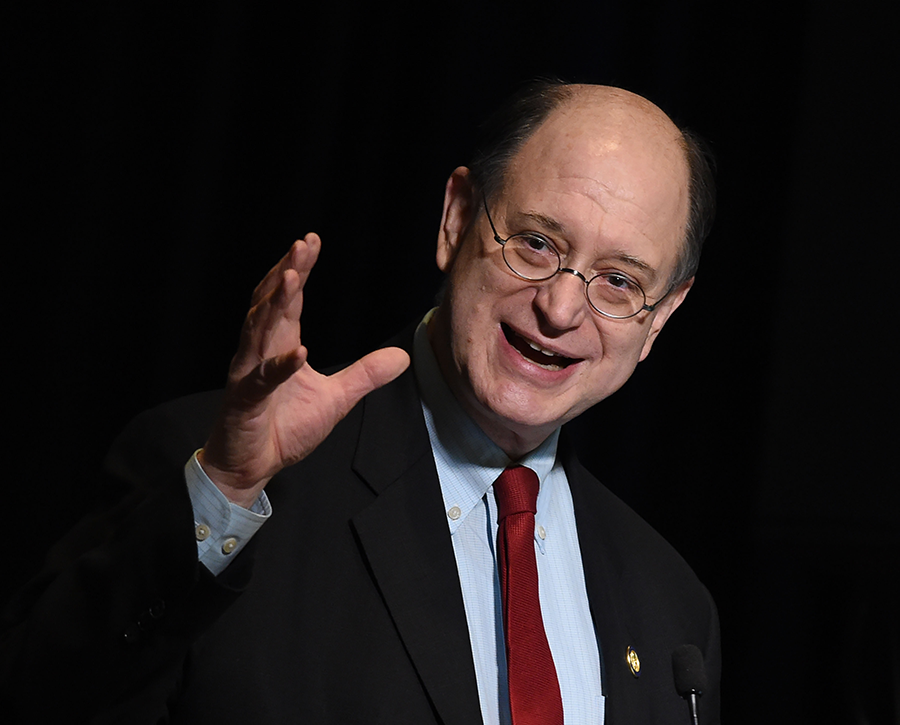 First elected to the House in 1996, Sherman became chairman of the subcommittee in January 2019. It oversees the bilateral nuclear cooperation agreements that must be negotiated before a foreign country can receive U.S. nuclear technology. These agreements are called “123 agreements” after the section of the Atomic Energy Act that mandates adherence to several nonproliferation criteria to enable fast-track congressional review. Some technology recipients, such as Taiwan and the United Arab Emirates, have exceeded these criteria by agreeing to the so-called gold standard of 123 agreements, in which they have pledged to abstain from enriching uranium or separating plutonium and to adopt an additional protocol to their safeguards agreement with the International Atomic Energy Agency (IAEA).
First elected to the House in 1996, Sherman became chairman of the subcommittee in January 2019. It oversees the bilateral nuclear cooperation agreements that must be negotiated before a foreign country can receive U.S. nuclear technology. These agreements are called “123 agreements” after the section of the Atomic Energy Act that mandates adherence to several nonproliferation criteria to enable fast-track congressional review. Some technology recipients, such as Taiwan and the United Arab Emirates, have exceeded these criteria by agreeing to the so-called gold standard of 123 agreements, in which they have pledged to abstain from enriching uranium or separating plutonium and to adopt an additional protocol to their safeguards agreement with the International Atomic Energy Agency (IAEA). Second, Saudi Arabia has broadly hinted that it wants to keep up with the Joneses, or in this case the ayatollahs, when it comes to a nuclear program. We know that the Iranian program is not merely for electricity, and Saudi Arabia wants to be just like the Iranians. So, I think they’ve told us why they want to have a nuclear program: they want to master the fuel cycle, they want to position themselves so that they can develop a nuclear weapon. And if there’s a government that you can’t trust with a bone saw, you shouldn’t trust it with nuclear weapons. We don’t need more nuclear powers in the world. We certainly don’t need any more in the Middle East.
Second, Saudi Arabia has broadly hinted that it wants to keep up with the Joneses, or in this case the ayatollahs, when it comes to a nuclear program. We know that the Iranian program is not merely for electricity, and Saudi Arabia wants to be just like the Iranians. So, I think they’ve told us why they want to have a nuclear program: they want to master the fuel cycle, they want to position themselves so that they can develop a nuclear weapon. And if there’s a government that you can’t trust with a bone saw, you shouldn’t trust it with nuclear weapons. We don’t need more nuclear powers in the world. We certainly don’t need any more in the Middle East. Born in Salt Lake City, Weiler studied at the University of Utah, where he failed to top his class, just missing out by one spot to Mary Recore, who would later become his wife of 72 years.
Born in Salt Lake City, Weiler studied at the University of Utah, where he failed to top his class, just missing out by one spot to Mary Recore, who would later become his wife of 72 years. Next came a faculty stint at Stanford before returning to governmental service in 1977 as U.S. ambassador and special coordinator for the UN Special Session on Disarmament.
Next came a faculty stint at Stanford before returning to governmental service in 1977 as U.S. ambassador and special coordinator for the UN Special Session on Disarmament. Michael T. Klare’s article “Autonomous Weapons Systems and the Laws of War” (
Michael T. Klare’s article “Autonomous Weapons Systems and the Laws of War” ( The continued use of chemical weapons with impunity is driving
The continued use of chemical weapons with impunity is driving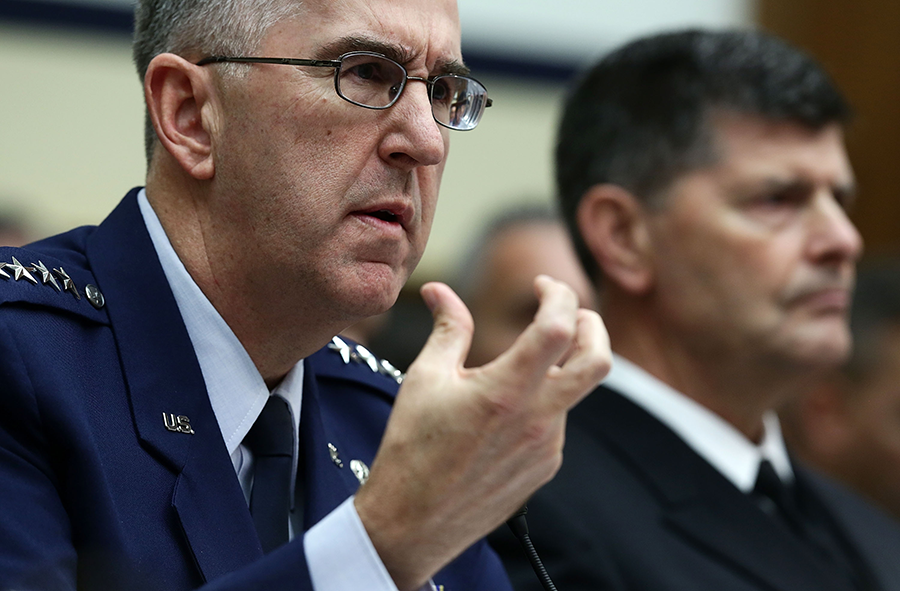 U.S. officials have avoided expressing a public position on extending the treaty and have expressed concern about Russia’s strategic weapons plans. Yleem Poblete, U.S. assistant secretary of state for arms control, verification, and compliance, told the UN Conference on Disarmament (CD) in Geneva on March 19 that Russia “remains in compliance” with the treaty, but she questioned whether Russia’s development of new nuclear weapons were the actions of a “responsible stakeholder.” One week earlier, Andrea Thompson, U.S. undersecretary of state for arms control and international security, told a Washington nuclear policy conference that the remaining two-year period offers plenty of time to review the pact.
U.S. officials have avoided expressing a public position on extending the treaty and have expressed concern about Russia’s strategic weapons plans. Yleem Poblete, U.S. assistant secretary of state for arms control, verification, and compliance, told the UN Conference on Disarmament (CD) in Geneva on March 19 that Russia “remains in compliance” with the treaty, but she questioned whether Russia’s development of new nuclear weapons were the actions of a “responsible stakeholder.” One week earlier, Andrea Thompson, U.S. undersecretary of state for arms control and international security, told a Washington nuclear policy conference that the remaining two-year period offers plenty of time to review the pact.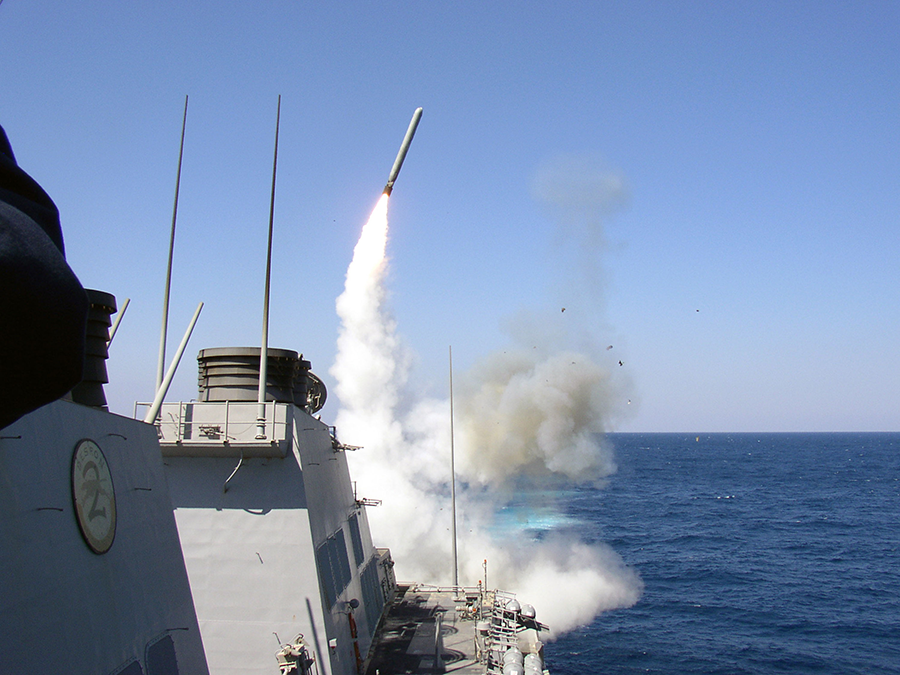 First, reportedly in August, the Pentagon plans to test a mobile, ground-launched variant of the Navy’s Tomahawk sea-launched cruise missile, with a 1,000-kilometer range. The new cruise missile could be deployed within 18 months, according to defense officials.
First, reportedly in August, the Pentagon plans to test a mobile, ground-launched variant of the Navy’s Tomahawk sea-launched cruise missile, with a 1,000-kilometer range. The new cruise missile could be deployed within 18 months, according to defense officials.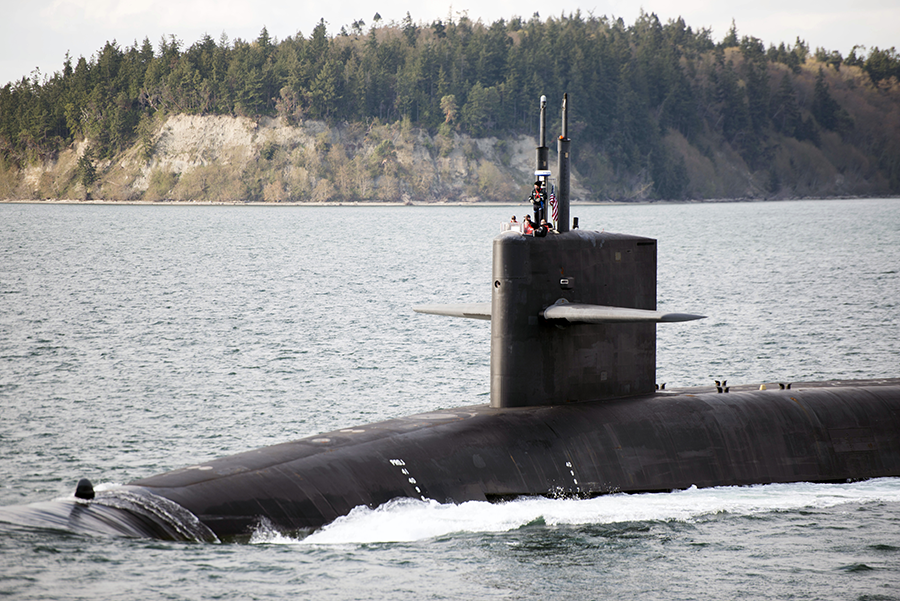 The ultimate fate of the request, submitted to Congress March 11, remains uncertain as Democrats, particularly in the House, have signaled strong opposition to several controversial funding proposals. Their concerns include administration plans to develop two additional low-yield nuclear weapons and two conventionally armed, ground-launched missiles currently prohibited by the 1987 Intermediate-Range Nuclear Forces (INF) Treaty.
The ultimate fate of the request, submitted to Congress March 11, remains uncertain as Democrats, particularly in the House, have signaled strong opposition to several controversial funding proposals. Their concerns include administration plans to develop two additional low-yield nuclear weapons and two conventionally armed, ground-launched missiles currently prohibited by the 1987 Intermediate-Range Nuclear Forces (INF) Treaty.